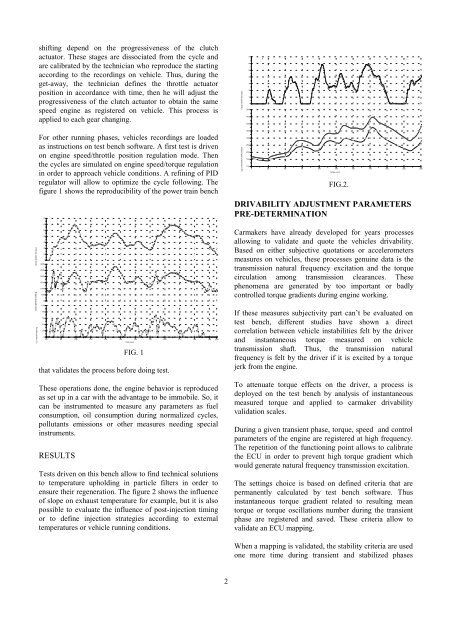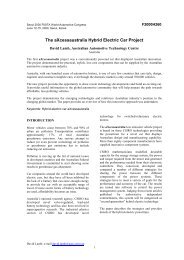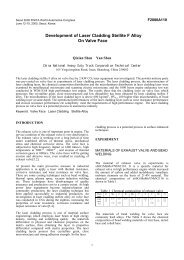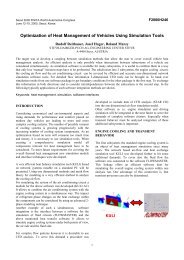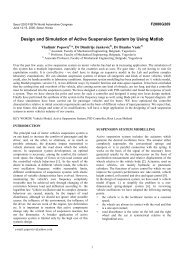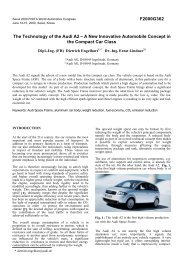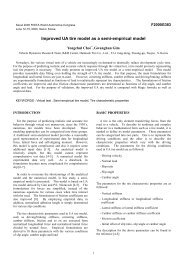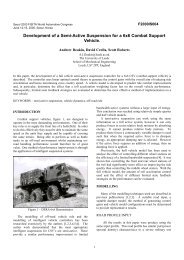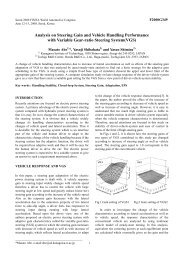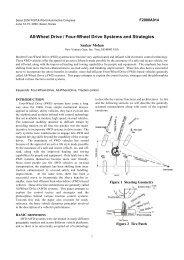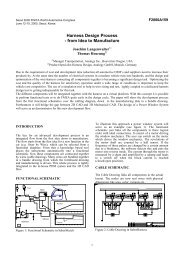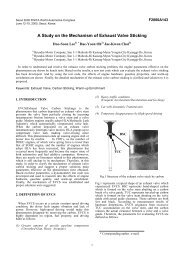Common Rail Mapping on Power train Test Bench
Common Rail Mapping on Power train Test Bench
Common Rail Mapping on Power train Test Bench
You also want an ePaper? Increase the reach of your titles
YUMPU automatically turns print PDFs into web optimized ePapers that Google loves.
Vehicule speed (km/h)<br />
Engine speed (rpm)<br />
Throttle positi<strong>on</strong> (%)<br />
shifting depend <strong>on</strong> the progressiveness of the clutch<br />
actuator. These stages are dissociated from the cycle and<br />
are calibrated by the technician who reproduce the starting<br />
according to the recordings <strong>on</strong> vehicle. Thus, during the<br />
get-away, the technician defines the throttle actuator<br />
positi<strong>on</strong> in accordance with time, then he will adjust the<br />
progressiveness of the clutch actuator to obtain the same<br />
speed engine as registered <strong>on</strong> vehicle. This process is<br />
applied to each gear changing.<br />
For other running phases, vehicles recordings are loaded<br />
as instructi<strong>on</strong>s <strong>on</strong> test bench software. A first test is driven<br />
<strong>on</strong> engine speed/throttle positi<strong>on</strong> regulati<strong>on</strong> mode. Then<br />
the cycles are simulated <strong>on</strong> engine speed/torque regulati<strong>on</strong><br />
in order to approach vehicle c<strong>on</strong>diti<strong>on</strong>s. A refining of PID<br />
regulator will allow to optimize the cycle following. The<br />
figure 1 shows the reproducibility of the power <strong>train</strong> bench<br />
70<br />
60<br />
50<br />
40<br />
30<br />
20<br />
10<br />
0<br />
3000<br />
2500<br />
2000<br />
1500<br />
1000<br />
500<br />
0<br />
100<br />
80<br />
60<br />
40<br />
20<br />
0<br />
85 95 105 115 125 135 145 155 165 175 185 195 200<br />
time (sec)<br />
that validates the process before doing test.<br />
These operati<strong>on</strong>s d<strong>on</strong>e, the engine behavior is reproduced<br />
as set up in a car with the advantage to be immobile. So, it<br />
can be instrumented to measure any parameters as fuel<br />
c<strong>on</strong>sumpti<strong>on</strong>, oil c<strong>on</strong>sumpti<strong>on</strong> during normalized cycles,<br />
pollutants emissi<strong>on</strong>s or other measures needing special<br />
instruments.<br />
RESULTS<br />
FIG. 1<br />
<strong>Test</strong>s driven <strong>on</strong> this bench allow to find technical soluti<strong>on</strong>s<br />
to temperature upholding in particle filters in order to<br />
ensure their regenerati<strong>on</strong>. The figure 2 shows the influence<br />
of slope <strong>on</strong> exhaust temperature for example, but it is also<br />
possible to evaluate the influence of post-injecti<strong>on</strong> timing<br />
or to define injecti<strong>on</strong> strategies according to external<br />
temperatures or vehicle running c<strong>on</strong>diti<strong>on</strong>s.<br />
Vehicule speed (km/h)<br />
exhaust gas temperature (캜)<br />
70<br />
60<br />
50<br />
40<br />
30<br />
20<br />
10<br />
500<br />
450<br />
400<br />
350<br />
300<br />
250<br />
200<br />
150<br />
0<br />
100<br />
0 25 50 75 100 125 150 175 200 225 250<br />
temps (sec)<br />
FIG.2.<br />
DRIVABILITY ADJUSTMENT PARAMETERS<br />
PRE-DETERMINATION<br />
Carmakers have already developed for years processes<br />
allowing to validate and quote the vehicles drivability.<br />
Based <strong>on</strong> either subjective quotati<strong>on</strong>s or accelerometers<br />
measures <strong>on</strong> vehicles, these processes genuine data is the<br />
transmissi<strong>on</strong> natural frequency excitati<strong>on</strong> and the torque<br />
circulati<strong>on</strong> am<strong>on</strong>g transmissi<strong>on</strong> clearances. These<br />
phenomena are generated by too important or badly<br />
c<strong>on</strong>trolled torque gradients during engine working.<br />
If these measures subjectivity part can’t be evaluated <strong>on</strong><br />
test bench, different studies have shown a direct<br />
correlati<strong>on</strong> between vehicle instabilities felt by the driver<br />
and instantaneous torque measured <strong>on</strong> vehicle<br />
transmissi<strong>on</strong> shaft. Thus, the transmissi<strong>on</strong> natural<br />
frequency is felt by the driver if it is excited by a torque<br />
jerk from the engine.<br />
To attenuate torque effects <strong>on</strong> the driver, a process is<br />
deployed <strong>on</strong> the test bench by analysis of instantaneous<br />
measured torque and applied to carmaker drivability<br />
validati<strong>on</strong> scales.<br />
During a given transient phase, torque, speed and c<strong>on</strong>trol<br />
parameters of the engine are registered at high frequency.<br />
The repetiti<strong>on</strong> of the functi<strong>on</strong>ing point allows to calibrate<br />
the ECU in order to prevent high torque gradient which<br />
would generate natural frequency transmissi<strong>on</strong> excitati<strong>on</strong>.<br />
The settings choice is based <strong>on</strong> defined criteria that are<br />
permanently calculated by test bench software. Thus<br />
instantaneous torque gradient related to resulting mean<br />
torque or torque oscillati<strong>on</strong>s number during the transient<br />
phase are registered and saved. These criteria allow to<br />
validate an ECU mapping.<br />
When a mapping is validated, the stability criteria are used<br />
<strong>on</strong>e more time during transient and stabilized phases<br />
2


